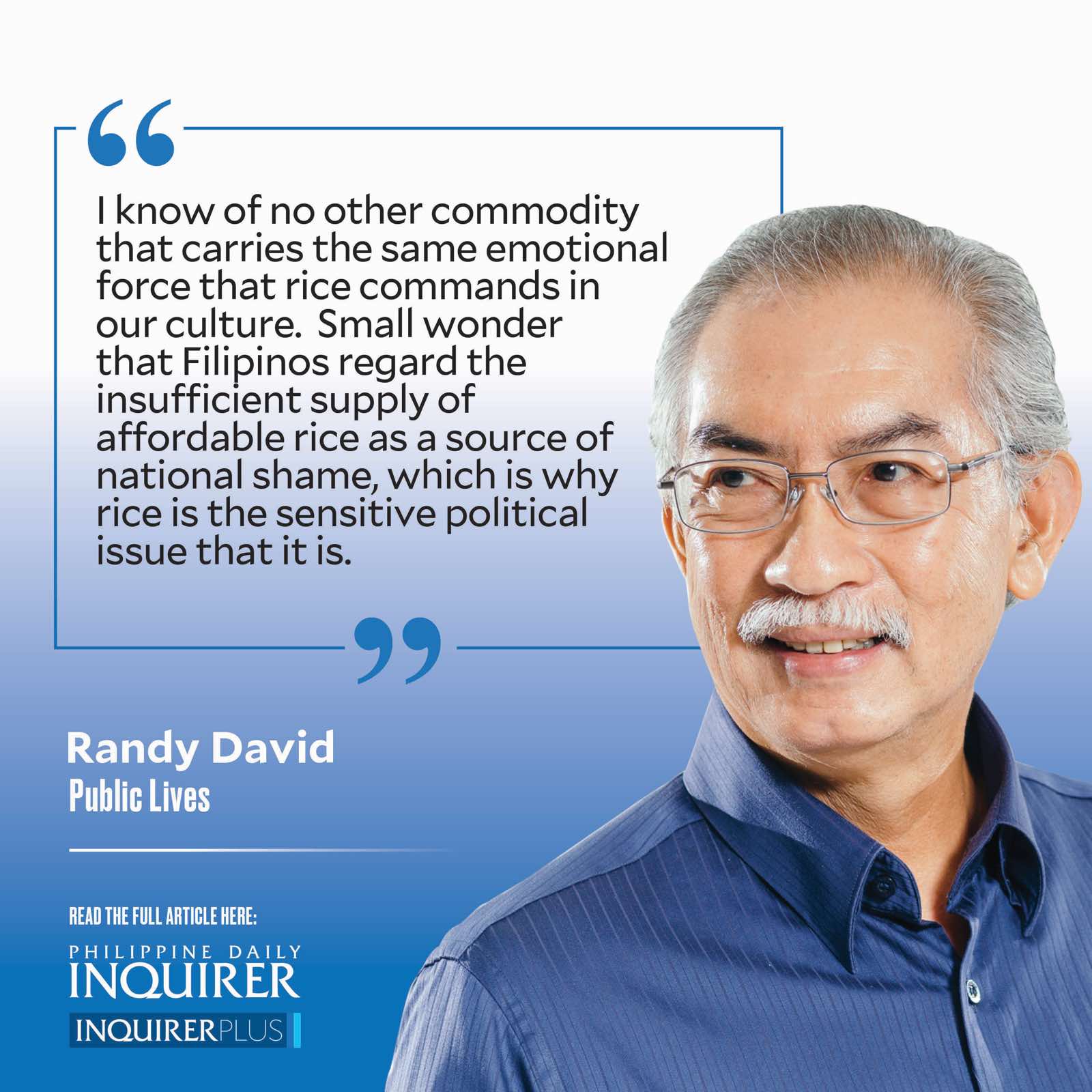The emotional issue of rice

The other day, I was briskly walking toward an automated teller machine (ATM), happy to see no one waiting, when an elderly man wearing a jacket and a hat emerged from behind a concrete post, shuffling toward the same machine. I stopped to give way. But instead of proceeding to the ATM window, he came up to me and whispered: “Tatanawin ko na malaking utang na loob kung mabigyan niyo ako ng pambili ng isang kilong bigas para sa aking mga apo.” (I would be most grateful If you could spare some money so I could buy a kilo of rice for my grandchildren.) I was momentarily stunned.
He was dressed in decent clothes and didn’t look like a typical beggar. He stood there with a stoop, making him look much older than he probably was. Something about his hesitant manner suggested to me that he was doing this in sheer desperation. Without much thought, I handed him a hundred-peso bill, and said that I hoped it would be enough to buy two kilos of rice for his grandchildren. Countless elderly people like him in our country find themselves having to look after the day-to-day needs of their grandchildren because the kids’ parents have gone away to look for work.
I know of no other commodity that carries the same emotional force that rice commands in our culture. Small wonder that Filipinos regard the insufficient supply of affordable rice as a source of national shame, which is why rice is the sensitive political issue that it is.
President Marcos knows this only too well. One of his major campaign promises, which got him a lot of attention, was to make rice available to Filipinos at P20 a kilo. To this day, he is being held to that promise. He took over the agriculture portfolio himself, he said, so he could better support the country’s agriculture during his presidency. His goal, as I understand it, is not just to reduce rice imports, but to make the country completely self-reliant in this commodity.
In February 2023, Mr. Marcos brought back the renowned agricultural scientist Dr. Leocadio S. Sebastian, who had previously resigned as Mr. Marcos’ operations undersecretary in the same department, this time as undersecretary for rice industry development. In this capacity, Dr. Sebastian knows better than to talk about rice self-sufficiency. At his press briefing in May this year, he was entirely focused on getting farmers to use biofertilizers in combination with inorganic fertilizers in order to improve soil fertility, which, he said, has been severely depleted by long years of application of inorganic fertilizers like urea.
Dr. Sebastian knows only too well how hard it is for the country to attain self-sufficiency in rice. In 2006, while he was executive director of Philippine Rice Research Institute, he cowrote with Robert S. Zeigler, the then director general of the International Rice Research Institute (IRRI), the foreword to a richly-documented book titled “Why Does The Philippines Import Rice?”
Written by a group of scientists on rice economy, this extremely accessible book is available as a PDF document in the IRRI website. It is useful to mention the most basic point made in this book, because we tend to heap all the blame on ourselves, the corruption in public agencies, the lack of adequate support from our institutions, and the laziness and inefficient methods of our farmers, for the country’s continuing dependence on rice importation.
While there is no single reason for why we need to import to augment our rice production, one factor stands out, according to the authors: “The Philippines imports rice because it is a nation of islands without any major river deltas like those in Thailand and Vietnam. The major traditional exporters are all on the Southeast Asian mainland (Thailand, Vietnam, Cambodia, and Myanmar), while the countries that have been consistently importing rice for more than a hundred years (Indonesia, the Philippines, Sri Lanka, Japan, Korea, and Malaysia) are all islands or narrow peninsulas.”
Before the passage of the rice tariffication law, the National Food Authority had the sole power to import rice. Rice importation was however severely restricted so as not to prejudice the interests of local rice growers. On this point, the authors write: “Although it is not widely known, Filipino farmers receive much higher prices for their palay … than do farmers in neighboring developing countries … Not surprisingly, the very high palay prices received by Filipino farmers translate into very high prices paid by consumers.”
Today, the situation is reversed. Because of the mandated price cap per kilo (for regular milled rice: P41 or $0.72 and for well-milled rice: P45 or $0.79), current rice prices in the Philippines are lower than those in most countries. Thus, even if they are now allowed to import, private traders are not importing. They are waiting for the price to go down in the world market, where the average price for 81 countries, as of August 2023, is $1.88 or P106.65 per kilo.
We could be rice self-sufficient if we consumed less rice. But the poor among our people are such large rice eaters because there isn’t much they can afford to buy to go with the rice.
—————-
public.lives@gmail.com




















